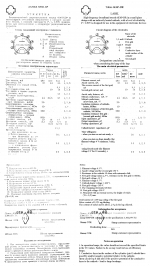I do not have a base configuration for this Russian tube but its a Tetrode and if you look at the base connections you will probably find the cathode is probably special high gain for military use and has more than one pin out from the same cathode to aid stability .
If that is the case and you are using it for audio then just use one pin out ( unless oscillation occurs ).
If that is the case and you are using it for audio then just use one pin out ( unless oscillation occurs ).
Good to know
I am using it triode connected. I think the "dr" designation means long-life, but I can't seem to find anything about the cathode being constructed of special material🙂
I am using it triode connected. I think the "dr" designation means long-life, but I can't seem to find anything about the cathode being constructed of special material🙂
If its military the cathode will be made out of superior material.
"DR" in Russia is usually the equivalent of British "SQ" + industrial tubes .
"DR" in Russia is usually the equivalent of British "SQ" + industrial tubes .
Multiple pins in RF tubes were done to reduce capacitance and to avoid or ease what was called "neutralization" in RF circuits (VHF, UHF). Most likely irrelevant for audio.
However, what is the point not to connect them, save a piece of wire ?
More important in case of the 6e6p / 6Э6П is to properly connect pin 8 to a slightly positive voltage. This applies to all variants of the 6e6p. Pin 8 connects to the thin gold wire which touches the glass wall from the inside which is coated. The reason seems to be to prevent accumulation of electrons at the inner wall. The russian data sheet is quite explicit here:
"Проводящий слой внутренней поверхности баллона (Вывод 8) должен иметь отрицательный потенциал относительно катода. Обрыв цепи Вывод 8, а также приложение положительного относительно катода потенциала к проводящему слою приводят к выходу лампы из строя."
"The conductive layer (=screen) inside the tube (Pin 8) should have a slight negative potential in relation to the cathode. If Pin 8 is left open, or a positive potential in relation to the cathode is applied, it can cause a tube failure" (or malfunction, the russian expression here is ambiguous).
By the way:
The letters after the dash (-) in russian tube designation have the following meaning:
V (Russian: В) – Increased reliability and mechanical ruggedness (such as low susceptibility to noise and microphonics).
R (Russian: Р) – Even better than V.
Ye (Russian: Е) – Extended service life.
D (Russian: Д) – Exceptionally long service life.
I (Russian: И) – Optimised for "pulsed" (i.e. switching) mode of operation.
K (Russian: К) – Vibration-resistant
However, what is the point not to connect them, save a piece of wire ?
More important in case of the 6e6p / 6Э6П is to properly connect pin 8 to a slightly positive voltage. This applies to all variants of the 6e6p. Pin 8 connects to the thin gold wire which touches the glass wall from the inside which is coated. The reason seems to be to prevent accumulation of electrons at the inner wall. The russian data sheet is quite explicit here:
"Проводящий слой внутренней поверхности баллона (Вывод 8) должен иметь отрицательный потенциал относительно катода. Обрыв цепи Вывод 8, а также приложение положительного относительно катода потенциала к проводящему слою приводят к выходу лампы из строя."
"The conductive layer (=screen) inside the tube (Pin 8) should have a slight negative potential in relation to the cathode. If Pin 8 is left open, or a positive potential in relation to the cathode is applied, it can cause a tube failure" (or malfunction, the russian expression here is ambiguous).
By the way:
The letters after the dash (-) in russian tube designation have the following meaning:
V (Russian: В) – Increased reliability and mechanical ruggedness (such as low susceptibility to noise and microphonics).
R (Russian: Р) – Even better than V.
Ye (Russian: Е) – Extended service life.
D (Russian: Д) – Exceptionally long service life.
I (Russian: И) – Optimised for "pulsed" (i.e. switching) mode of operation.
K (Russian: К) – Vibration-resistant
Attachments
Greatly appreciated!
Very good info, thanks to all and very good to have english translation of data sheet that came with the tube😀
Very good info, thanks to all and very good to have english translation of data sheet that came with the tube😀
- Home
- Amplifiers
- Tubes / Valves
- 6e6p-dr cathode connections
